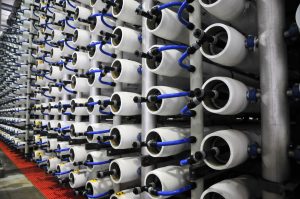J-WAFS in action: Good vibrations – reducing the cost of water desalination

Xuanhe Zhao, Noyce Career Development Professor in the Department of Mechanical Engineering at MIT, and Dr. John Lienhard, Abdul Latif Jameel Professor of Water and Food at MIT and the Director of J-WAFS, are leading one of seven research projects awarded J-WAFS funding earlier this year. Xuanhe and John aim to develop a chemical-free, vibration-based membrane cleaning technology that could dramatically improve the efficiency – and reduce the costs – of reverse osmosis, the most widely used desalination process in the world.
Opening Doors spoke to professors Zhao and Lienhard about the project and its aims.
What is the title of your research project?
The project is called ‘High-efficiency Chemical-Free Backwash Strategy for Reverse Osmosis Membrane Antifouling’.
What issue are you seeking to address?
Fresh water is fundamental to our existence, but ensuring a stable, sustainable supply is a huge challenge, particularly in water-scarce areas like the Middle East and North Africa (MENA).
In theory, there is enough fresh water on Earth to support seven billion people, but a combination of uneven distribution and inefficient consumption patterns mean that an increasing number of regions are chronically short of water, with vast volumes being wasted, polluted or unsustainably managed.
According to World Bank data, more than half of the population in MENA live under conditions of ‘water stress’, where demand outstrips supply[1]. Although this is perhaps not surprising in an area containing 12 of the world’s most water-scarce countries, the scale of the difference between supply and demand is alarming.
With the pressure on water supply set to increase yet further as population growth and the effects of global climate change take their toll, water availability per capita in the MENA region is expected to halve by 2050[2].
There are several technologies in use around the world that use desalination technologies to increase the supply of fresh water. The UAE, for example, gets 90% of its water through desalination.
The most widely used process globally is reverse osmosis. Our research aims to develop new technology that will significantly improve the efficiency, enhance the sustainability and reduce the costs of the reverse osmosis process.
What is reverse osmosis?
Reverse osmosis is used for both brackish groundwater desalination and for seawater desalination. It is also used as an element of wastewater reuse systems and in a variety of other processes.
During reverse osmosis, saline water is pressurized on one side of a polymer membrane, causing water to pass through the membrane to the low pressure (pure water) side. Salts cannot pass through the membrane because of the carefully designed surface chemistry of the membrane.

What are some of the problems associated with it?
The main problem we are interested in is fouling of the membrane. In operation, thin films of biologically active material can form on the saltwater side of the membrane. In addition, salts can crystallize on the membrane surface. Both processes effectively ‘clog up’ the membrane, which decreases the transfer of water from one side to the other and leads to higher energy consumption and costs. So, it’s very important to control it.
The problem of biofilm membrane fouling is usually addressed by extensive chemical pre-treatment of the incoming feed water. But this is costly, time- and energy-inefficient, and environmentally undesirable. In addition, it doesn’t totally eradicate membrane fouling and it constrains the lifetime of membranes. It would, therefore, be preferable to have a chemical-free method that further extended the working life of the membranes and reduced operating and maintenance costs.
How does your research propose to overcome these challenges?
The approach that we are researching is to use pressure to vibrate the membranes. Bacteria use something called ‘quorum sensing’ to determine whether there are enough of them to form a colony. The vibrations interfere with the ‘quorum sensing’ and prevent the bacteria developing into biofilms.
The vibrations are produced by applying a pressure gradient to one side of the membrane. On the other side, the pressure is constant. The difference between the oscillating gradient on one side and the constant pressure on the other side causes the membrane to vibrate. This can be done during the regular desalination process.
We need to conduct further study in the lab into how bacteria adhere to the membrane surface and how vibration affects communication between bacteria. Once we’ve done that, we can look to apply these principles in the real world.
What are the potential benefits of your technology?
The main benefits are in reduced maintenance and operating costs of the reverse osmosis process. Less downtime is required to clean the membranes, as they are not fouled with biofilm, so productivity is greater: you can produce more water in a given period of time if you don’t have to shut down the process for cleaning. At the same time, you avoid the costs involved in the cleaning process itself. Eliminating membrane anti-fouling also makes it easier for reverse osmosis to work with the very saline, warm water you find in the Gulf and other parts of the world.
There should also be a benefit for consumers, in the that it should lower the cost of water. Currently, operating and maintenance costs account for about a quarter of the cost of water from a reverse osmosis plant. Membrane cleaning and replacement are a significant contributor to that. So, if we can reduce those costs, the overall cost of production should come down significantly.
There will also be less risk of perforated membranes or something getting through, so the quality of the water is probably going to be better, as well.
Do you expect to have completed your research by August 2019, when this round of J-WAFS funding comes to an end?
Yes, we think this stage of the research – to prove the hypothesis – should be complete. After that, we see the potential for further research to refine the process and how it can be applied commercially.
The initial focus of our project is anti-fouling of reverse osmosis membranes, but the scope of our research and the knowledge we obtain could also be applied to other applications where bio-fouling is a problem, such as the hulls of ships, or medical implants, so there is significant commercial potential.

Dr. John H. Lienhard V, PhD, PE, Abdul Latif Jameel Professor of Water and Food at MIT and the Director of J-WAFS
[1] High and Dry: Climate Change, Water and the Economy, World Bank, May 2016.
[2] http://blogs.worldbank.org/arabvoices/numbers-facts-about-water-crisis-arab-world


 Added to press kit
Added to press kit


